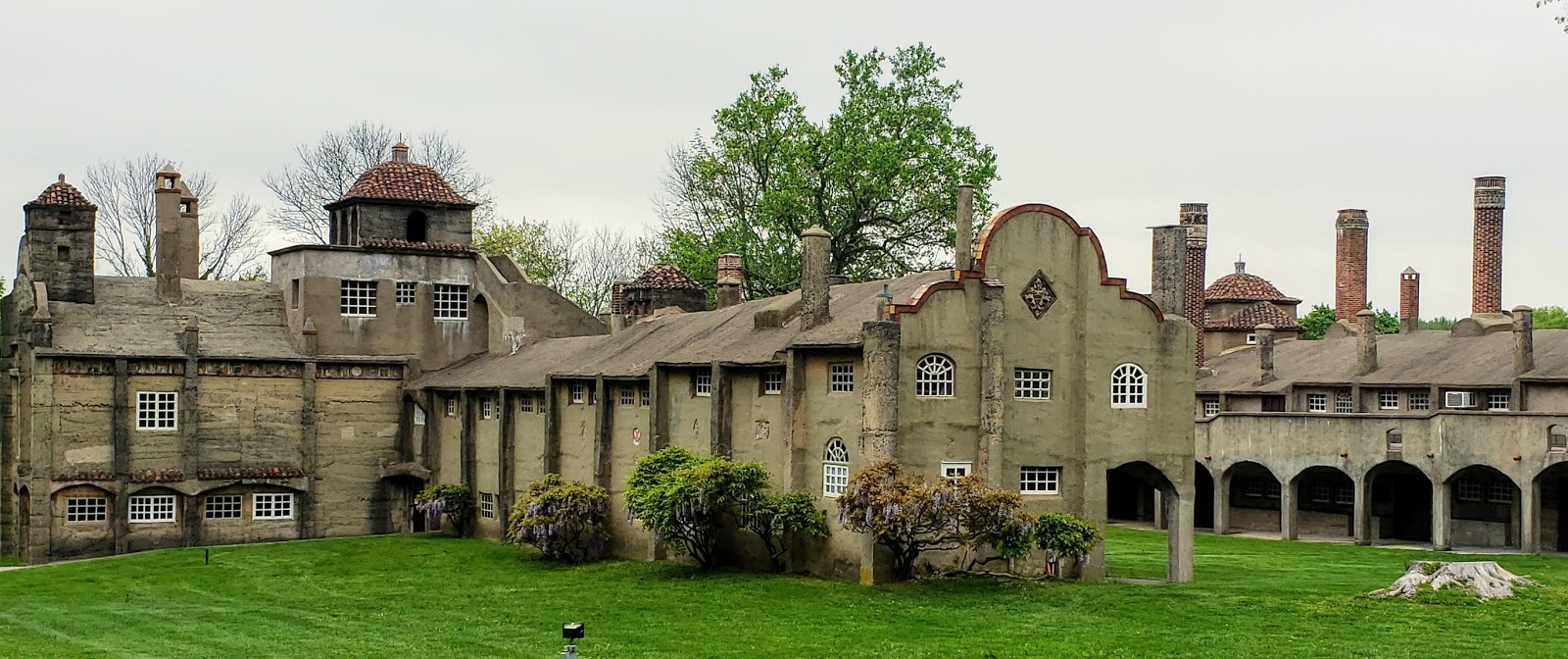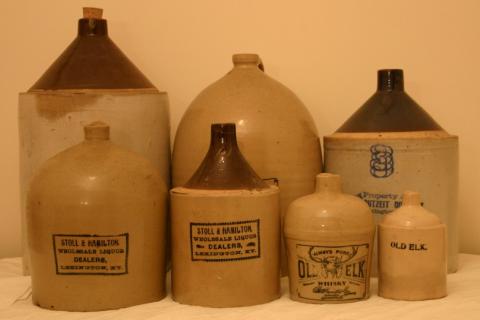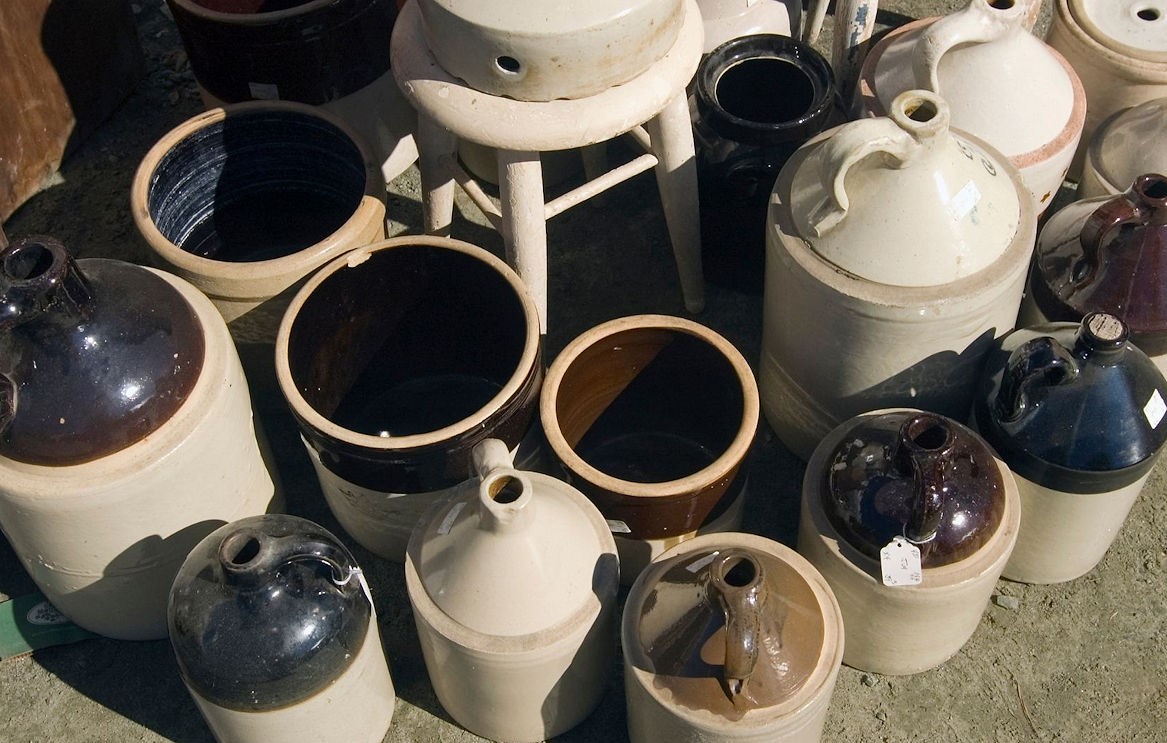Years ago, I was reading an old history book which referenced “jug towns.” It explained that jug towns were essentially early factory towns. These scattered settlements sprang up around clay deposits along the eastern seaboard, inland of developing cities. Philadelphia had a number of clay works. New York City and Alexandria, Virginia had their share as well. A famous clay deposit in my own neck of the woods became a famous tile works- the Moravian Tile Works.

Jugs and similar vessels have always been necessities at the dinner table and for food storage, so establishing sources for clay was crucial for American colonists. Earthenware and stoneware were the most commonly used storage containers before the 19th century. Pottery was basically heavy, colonial Tupperware! Jugs full of liquids (syrups, oils, spirits, etc.) made their way to market on flatboats and keelboats, but they were most often used at the point of sale/purchase for items. Jugs quickly became associated with distilled spirits in colonial America. The name “Jugtown” became a commonly used name for local towns- either for its clay works and local pottery production efforts, or simply because a town became associated with excessive liquor consumption! Where there were jugs, there was sure to be rum or whiskey.
Locals brought their empty jugs to the general store and filled them up with whiskey to bring back home. By the mid-1800s, salesmen were using jugs to advertise their products and market their businesses. Jugs labeled with ink stencils or stamps were given as gifts to a saloon, hotel, or restaurant for the dispensing of their spirits to customers. These stoneware advertising jugs are fairly common today and can be found in almost every antique store.

It’s interesting to note that the sizes of jugs used for liquor during the early 1800s tended to be in 1-3 gallons, but became smaller- a gallon or less- in the late 1800s after laws were established that limited distilleries to ONLY wholesale sales of “no less than 1 gallon”. Distilleries, after 1887, were only allowed to sell wholesale packages of one gallon or more, so more of their business shifted toward selling whiskey in barrels (in bulk) only. This is why you don’t tend to see distillery names on old jugs. The labels on early jugs may include a “household brand” name, but the business’s name emblazoned on that jug will always advertise the retail establishment marketing that brand to the public. Once glass manufacturing began to industrialize and establish itself in the late 1800s, pottery businesses begin to disappear. What had once been an absolute necessity for the whiskey industry was quietly phased out by the Mason jar and the glass bottle.
Jugs resurface in the mid-twentieth century to sell nostalgia for a bygone era. Lebanon County, Pennsylvania’s Lou Forman launched his new brand, “Michter’s Sour Mash Pot Still Whiskey”, in the late 1950s in 750 ml jugs. They were meant to evoke the colonial origins of the distillery site where his whiskeys were produced. The distillery where Michter’s jugs were filled was still known as Kirk’s Pure Rye Whiskey Distillery when the brand was launched (and would soon be known as Pennco Distillery), but the distillery was more commonly referred to as the old Bomberger Distillery. Ceramic jugs became more common among distillery companies in the 1970s and 80s as they sought to move surplus whiskey stocks. Jugs, themed decanters, and limited edition, glazed pottery full of whiskey were sold as collectibles for people’s book shelves. The jug became less of a vessel for storing whiskey than a prop to sell whiskey. The whiskey industry found a previously untapped consumer base in collectors- of tchotchkes. Many of these jugs and decanters were sold to collectors with no intention of drinking the whiskey inside. They were only purchased once by customers wishing to display the item, so many were advertised as valuable limited editions to encourage collectors to invest in several. Many that survive today are still full of whiskey, largely because most of the decanters were sold to this non-whiskey drinking demographic. These modern-era whiskey jugs were manufactured in factories in the U.S.A., but many (especially those manufactured for Jim Beam) were made abroad in France- or even as far away as Australia.


